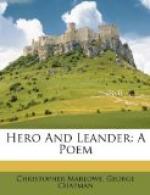|
This section contains 2,304 words (approx. 8 pages at 300 words per page) |

|
SOURCE: Cantelupe, Eugene B. “Hero and Leander: Marlowe's Tragicomedy of Love.” College English 24, no. 4 (January 1963): 295-98.
In the following essay, Cantelupe discusses Hero and Leander as a tragicomedy.
The seriocomic “Court of Love,” the anonymous erotic allegory written in the early part of the sixteenth century, foretells certain Ovidian poems that appear at the end of the century. English poets of the Ovidian school, like the humanists of Northern Europe, show a divided loyalty to paganism and to Christian morality.1 In the sixties and seventies, such poets as Churchyard, Gascoigne, and Turberville sought refuge in Golding's allegorical interpretation of Ovid, the medieval solution; and in the eighties and nineties, when the Italianate Ovidian tradition—with its glorification of the senses and the imagination—was in vogue, such poets as Lodge, Marlowe, and Shakespeare resorted to wit and sophisticated humor.2 Their solution was not incompatible with the late Elizabethan...
|
This section contains 2,304 words (approx. 8 pages at 300 words per page) |

|


